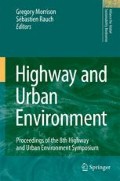The aim of this project was to find effective reactive materials as use in soil-bed barriers, for remediation of soil contaminated with chromium at Stallbacka industrial area in Sweden. Materials with different reduction/ adsorption capacities of Cr(VI)/Cr(III) were tested in laboratory and in a field pilot-scale experiment. Concentrations of total Cr and Cr(VI) in the soil, highly contaminated with ferrochrome slag, were exceeding the guideline values for contaminated sites in Sweden.
Zero-valent iron (Fe0) filling, FeSO4 o7H2O, Na2SO3, field pine bark, modified pine bark, pine sawdust, and sphagnum peat were tested in batch or columns in mixture with the contaminated soil. All the materials, except peat, showed a good ability to reduce Cr(VI) in the batch experiments, and were chosen for further dynamic studies in columns. Iron sulphate and sodium sulphite were both shown to have a good ability to quickly reduce Cr(VI) in the columns, but the use might result in leaching of Fe and SO2- 4 to surface and groundwater. For field bark it took a longer time to reduce/ adsorb the same amounts of chromium, but it was functional for a longer time.
Reactive soil-bed barriers were constructed in field: soil with embedded layers of FeSO4, pine bark underlying the soil, and soil without any reactive material layer. The iron sulphate was determined not to be suitable for the soil treatment, due to the high percentage of coarse materials in the soil texture, and thereby a quick washout of FeSO4 during the water infiltration. The field reactive soil barrier with pine bark was proven to be effective in reducing Cr(VI), and also had the capacity to adsorb both total and dissolved chromium leaching from the contaminated soil.
Access this chapter
Tax calculation will be finalised at checkout
Purchases are for personal use only
Preview
Unable to display preview. Download preview PDF.
References
Interstate Technology and Regulatory Council (2005) Permeable reactive barriers: lessons learned/new directions. PRB-4. Washington, DC. Also at www.itrcweb.org
Vidic RD (2001) Permeable reactive barriers: case study review, Technology evaluation report, TE-01-01. Ground-Water Remediation Technologies Analysis Center, Pittsburgh
Birke V, Burmeier H, Rosenau D (2003) Design, construction, and operation of tailored permeable reactive barriers. Pract Period Hazard Toxic Radioact Waste Manage 7:264-280
Powell RM, Puls RW, Powell PD (2002) Cost analysis of permeable reactive barriers for remediation of groundwater. In: Gavaskar AR, Chen ASC, Monterey CA (eds.) Proceedings of the international conference on remediation of chlorinated and recalcitrant compounds, 3rd edn., United States, May 20-23, 2002, 104-11. Battelle Press, Columbus, OH
Hansel CM, Wielinga BW, Fendorf S (2003). Fate and stability of Cr following reduction by microbial generated Fe (II). Department of Geological and Environmental Science, Stanford University, MFG, Inc., Fort Collins, CO
Palmer CD, Wittbrodt PR (1991) Processes affecting the remediation of chromium-contaminated sites. Environ Health Perspec 92:25-40
Palmer CD, Puls R (1994) Natural attenuation of hexavalent chromium in groundwater and soil. EPA/540S-94. US Environmental Protection Agency. Groundwater issue
Sass BM, Rai D (1987) Volubility of amorphous chromium(III)-iron(III) hydroxide solid solutions. Inorg Chem 26:2228-2232
Walter GR, Yiannakakais A, Chammas G (2001) Applying geochemical methods to remediate chromium contamination. Hydro Geo Chem, Inc, Tucson, AZ
Swedish Environmental Protection Agency(2002). Contaminated sites. Report 5053
U.S. EPA (2002) In situ treatment of soil and groundwater contaminated with chromium - technical resource guide. United States Environmental Protection Agency, EPA/625/R-005, October, 2000
Fetter CW (1999) Contaminant hydrogeology. 3rd edn. Prentice Hall, Upper Saddle River, NJ
Beukes JP, Pienaar JJ, Lachmann G, Giesekke EW (1999) The reduction of hexavalent chromium by sulphite in wastewater. Water SA 25:363-370
Bailey SE, Olin TJ, Bricka RM, Adrian DD (1999) A review of potentially low-cost sorbents for heavy metals. Wat Res 33:2469-2479
Sharma DC, Forster CF (1995) Column studies into the adsorption of chro-mium(VI) using sphagnum moss peat. Bioresour Technol 52:261-267
DSNR’s Centre for Natural Resources (CNR) Wellington Laboratory (1999) Soil survey standard test method. Also at http://www.dlwc.nsw.gov.au/care/ soil/soil_pubs/soil_tests/pdfs/mc.pdf
Standard methods for the examination of water and wastewater (1998) 20. edn., Lenore S. Clesceri et al. (eds.) American Public Health Association Board. California Environmental Protection Agency, New York
Kalmykova Y, Strömvall A-M, Steenari B-M (2006a) Alternative materials for adsorption of heavy metals and petroleum hydrocarbons from contaminated leachates. Environ Technol (submitted)
Kalmykova Y, Strömvall A-M, Steenarie B-M (2006b) Adsorption of Cd, Cu, Ni, Pb and Zn on sphagnum peat from solutions with low metal concentrations. J of Hazard Mat (submitted)
Seaman JC, Bertsch PM, Schwallie L (1999) In situ Cr(VI) reduction within coarse-textured, oxide-coated soil and aquifer systems using Fe(II) solutions. Environ Sci Technol 33:938-944
Geelhoed JS, Meeussen JCL, Roe MJ, Hillier S, Thomas RP, Farmer JG, Paterson E (2003) Chromium remediation or release? Effect of iron(II)sulfate addition on chromium(VI) leaching from columns of chromite ore processing residue, Environ Sci Technol 37:3206-3212
Author information
Authors and Affiliations
Editor information
Editors and Affiliations
Rights and permissions
Copyright information
© 2007 Springer
About this paper
Cite this paper
Strömvall, AM., Norin, M., Inanta, H. (2007). Reactive soil barriers for removal of chromium(VI) from contaminated soil. In: Morrison, G.M., Rauch, S. (eds) Highway and Urban Environment. Alliance For Global Sustainability Bookseries, vol 12. Springer, Dordrecht. https://doi.org/10.1007/978-1-4020-6010-6_27
Download citation
DOI: https://doi.org/10.1007/978-1-4020-6010-6_27
Publisher Name: Springer, Dordrecht
Print ISBN: 978-1-4020-6009-0
Online ISBN: 978-1-4020-6010-6
eBook Packages: Earth and Environmental ScienceEarth and Environmental Science (R0)

